Virtual Science Museum
CED Player
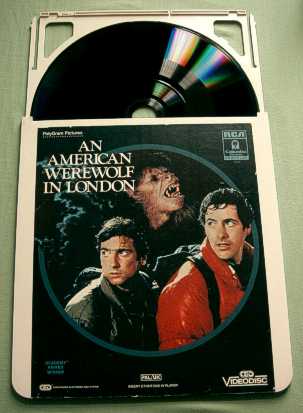 The RCA Capacitance Electronic Disc system was launched in 1981 and was only around for
about five years. It pre-dates Laser Disc by several years. It uses a diamond stylus
to play a grooved 12" conductive disc. The signal is read as variations in capacitance
between the stylus and the disc. There are 375 grooves per millimeter compared to a
maximum of 14 per millimeter on a long play record. The system is so sensitive to
finger prints and dust that the discs are contained in caddies.
The RCA Capacitance Electronic Disc system was launched in 1981 and was only around for
about five years. It pre-dates Laser Disc by several years. It uses a diamond stylus
to play a grooved 12" conductive disc. The signal is read as variations in capacitance
between the stylus and the disc. There are 375 grooves per millimeter compared to a
maximum of 14 per millimeter on a long play record. The system is so sensitive to
finger prints and dust that the discs are contained in caddies.
To load a disc, the caddy is inserted into the front of the player and then withdrawn again.
The disc remains in the machine and the caddy comes out empty.
With a good disc, the picture quality is comparable with VHS tape. Not surprisingly,
tracking problems are common. To alleviate this, the system automatically advances the
stylus if the same revolution of grove gets played more than once. This often occurs on
a number of revolutions in succession, with rather bizarre results.
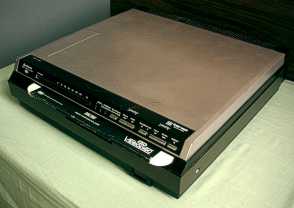 The PAL system can hold 75 minutes of program material on each side of the disc. When the
player gets to the end of side one, the screen goes black disconcertingly. To play side
two, the disc has to be turned over manually. This is done by inserting the caddy and
withdrawing it again. The caddy then comes out with the disc in it. The caddy is then
turned over, inserted into the machine and withdrawn again. The disc is then in the machine
the other way up and side two starts playing.
The PAL system can hold 75 minutes of program material on each side of the disc. When the
player gets to the end of side one, the screen goes black disconcertingly. To play side
two, the disc has to be turned over manually. This is done by inserting the caddy and
withdrawing it again. The caddy then comes out with the disc in it. The caddy is then
turned over, inserted into the machine and withdrawn again. The disc is then in the machine
the other way up and side two starts playing.
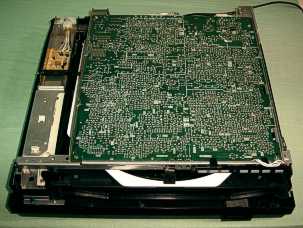 This is a Hitachi VIP201P CED player. It has stereo sound and infra-red remote control. This
is the same machine as above, with the top cover removed. A film has been loaded and the
edge of the disc can be seen at the front of the machine, just under the main printed
circuit board (PCB). The white part is the inside of the caddy, which remains in the
player with the disc. On the left hand side is a motorized 'gantry' which runs the length
of the machine, from front to back. It is driven by a motor and belt at the back of the
machine which moves it to the right as the disc is played.
This is a Hitachi VIP201P CED player. It has stereo sound and infra-red remote control. This
is the same machine as above, with the top cover removed. A film has been loaded and the
edge of the disc can be seen at the front of the machine, just under the main printed
circuit board (PCB). The white part is the inside of the caddy, which remains in the
player with the disc. On the left hand side is a motorized 'gantry' which runs the length
of the machine, from front to back. It is driven by a motor and belt at the back of the
machine which moves it to the right as the disc is played.
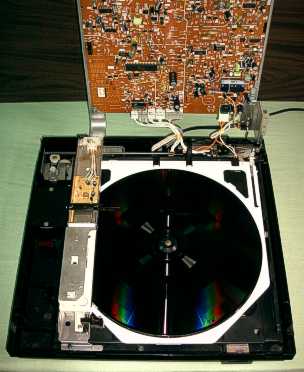 Here, the main PCB has been raised while the machine is playing. Note that the gantry has
moved across to the disc. The stylus is located in the front part of the gantry with the
signal amplifier mounted directly behind it. The motor which drives the gantry can be
seen in the rear left hand corner.
Here, the main PCB has been raised while the machine is playing. Note that the gantry has
moved across to the disc. The stylus is located in the front part of the gantry with the
signal amplifier mounted directly behind it. The motor which drives the gantry can be
seen in the rear left hand corner.
When a disc is loaded, switches tell the machine when the caddy has been withdrawn fully.
A motor then lowers the transport so that the disc engages with the spindle motor. Another
switch tells the machine when the transport is fully lowered. The gantry then moves across
to the disc and stops when an infra-red beam is broken by an arm on the gantry. The stylus
is then lowered onto the disc.
The part of the caddy which remains in the player is shaped on the leading edge, to identify
which side is playing. When side two is loaded, a switch is pressed. This lights an
indicator on the front of the machine.
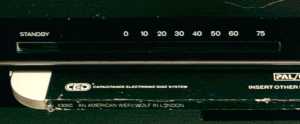 The play time indicator is simply a light emitting diode (LED) mounted on the gantry. The
LED is viewed through a window. As the film is played, the gantry traverses the disc, and
the LED moves across the window.
The play time indicator is simply a light emitting diode (LED) mounted on the gantry. The
LED is viewed through a window. As the film is played, the gantry traverses the disc, and
the LED moves across the window.
 This is the stylus cartridge. It fits in the front section of the gantry. The overall
length of the cartridge is 95mm. The actual stylus is on the right hand side.
This is the stylus cartridge. It fits in the front section of the gantry. The overall
length of the cartridge is 95mm. The actual stylus is on the right hand side.
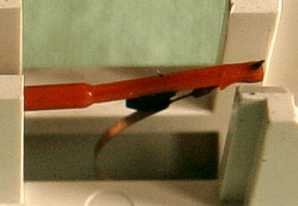 This is a close-up of the stylus. The area shown in this picture is 11mm wide. The ribbon
loop, which is probably beryllium copper, connects the stylus to the signal amplifier. The
amplifier is mounted on the gantry, close to the stylus to minimize stray capacitance and
electrical noise.
This is a close-up of the stylus. The area shown in this picture is 11mm wide. The ribbon
loop, which is probably beryllium copper, connects the stylus to the signal amplifier. The
amplifier is mounted on the gantry, close to the stylus to minimize stray capacitance and
electrical noise.
Coils mounted either side of the stylus control the gantry motor so that the stylus
does not get pulled too far to one side. There are also coils which raise and lower the
stylus and control the tracking force.
Much more information is available at
CED Magic.
 The RCA Capacitance Electronic Disc system was launched in 1981 and was only around for
about five years. It pre-dates Laser Disc by several years. It uses a diamond stylus
to play a grooved 12" conductive disc. The signal is read as variations in capacitance
between the stylus and the disc. There are 375 grooves per millimeter compared to a
maximum of 14 per millimeter on a long play record. The system is so sensitive to
finger prints and dust that the discs are contained in caddies.
The RCA Capacitance Electronic Disc system was launched in 1981 and was only around for
about five years. It pre-dates Laser Disc by several years. It uses a diamond stylus
to play a grooved 12" conductive disc. The signal is read as variations in capacitance
between the stylus and the disc. There are 375 grooves per millimeter compared to a
maximum of 14 per millimeter on a long play record. The system is so sensitive to
finger prints and dust that the discs are contained in caddies. The PAL system can hold 75 minutes of program material on each side of the disc. When the
player gets to the end of side one, the screen goes black disconcertingly. To play side
two, the disc has to be turned over manually. This is done by inserting the caddy and
withdrawing it again. The caddy then comes out with the disc in it. The caddy is then
turned over, inserted into the machine and withdrawn again. The disc is then in the machine
the other way up and side two starts playing.
The PAL system can hold 75 minutes of program material on each side of the disc. When the
player gets to the end of side one, the screen goes black disconcertingly. To play side
two, the disc has to be turned over manually. This is done by inserting the caddy and
withdrawing it again. The caddy then comes out with the disc in it. The caddy is then
turned over, inserted into the machine and withdrawn again. The disc is then in the machine
the other way up and side two starts playing. This is a Hitachi VIP201P CED player. It has stereo sound and infra-red remote control. This
is the same machine as above, with the top cover removed. A film has been loaded and the
edge of the disc can be seen at the front of the machine, just under the main printed
circuit board (PCB). The white part is the inside of the caddy, which remains in the
player with the disc. On the left hand side is a motorized 'gantry' which runs the length
of the machine, from front to back. It is driven by a motor and belt at the back of the
machine which moves it to the right as the disc is played.
This is a Hitachi VIP201P CED player. It has stereo sound and infra-red remote control. This
is the same machine as above, with the top cover removed. A film has been loaded and the
edge of the disc can be seen at the front of the machine, just under the main printed
circuit board (PCB). The white part is the inside of the caddy, which remains in the
player with the disc. On the left hand side is a motorized 'gantry' which runs the length
of the machine, from front to back. It is driven by a motor and belt at the back of the
machine which moves it to the right as the disc is played. Here, the main PCB has been raised while the machine is playing. Note that the gantry has
moved across to the disc. The stylus is located in the front part of the gantry with the
signal amplifier mounted directly behind it. The motor which drives the gantry can be
seen in the rear left hand corner.
Here, the main PCB has been raised while the machine is playing. Note that the gantry has
moved across to the disc. The stylus is located in the front part of the gantry with the
signal amplifier mounted directly behind it. The motor which drives the gantry can be
seen in the rear left hand corner. The play time indicator is simply a light emitting diode (LED) mounted on the gantry. The
LED is viewed through a window. As the film is played, the gantry traverses the disc, and
the LED moves across the window.
The play time indicator is simply a light emitting diode (LED) mounted on the gantry. The
LED is viewed through a window. As the film is played, the gantry traverses the disc, and
the LED moves across the window. This is the stylus cartridge. It fits in the front section of the gantry. The overall
length of the cartridge is 95mm. The actual stylus is on the right hand side.
This is the stylus cartridge. It fits in the front section of the gantry. The overall
length of the cartridge is 95mm. The actual stylus is on the right hand side. This is a close-up of the stylus. The area shown in this picture is 11mm wide. The ribbon
loop, which is probably beryllium copper, connects the stylus to the signal amplifier. The
amplifier is mounted on the gantry, close to the stylus to minimize stray capacitance and
electrical noise.
This is a close-up of the stylus. The area shown in this picture is 11mm wide. The ribbon
loop, which is probably beryllium copper, connects the stylus to the signal amplifier. The
amplifier is mounted on the gantry, close to the stylus to minimize stray capacitance and
electrical noise.